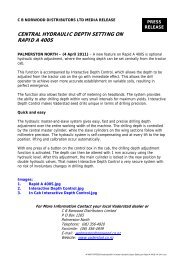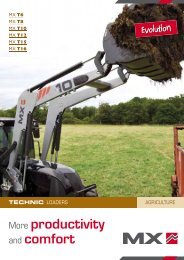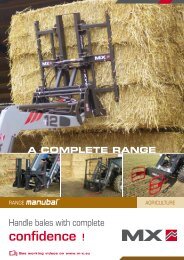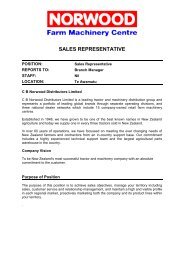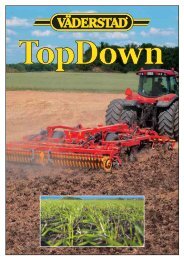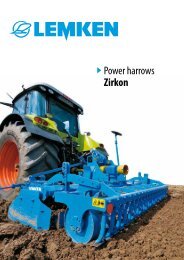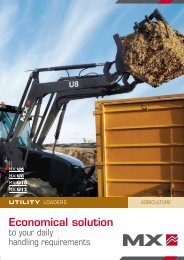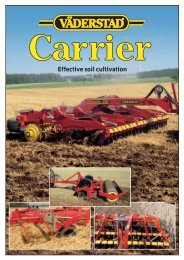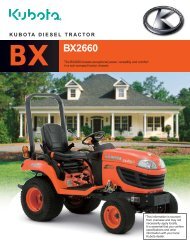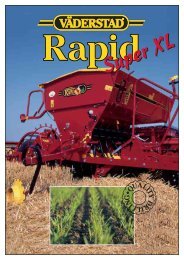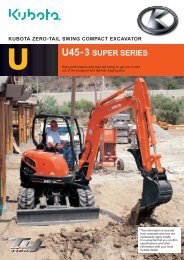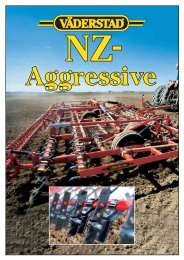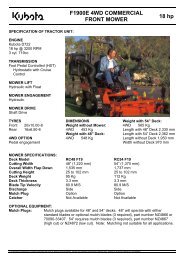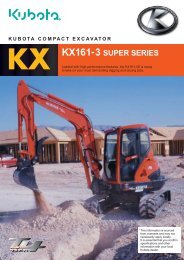Vaderstad Rollers Brochure - LiveUpdater
Vaderstad Rollers Brochure - LiveUpdater
Vaderstad Rollers Brochure - LiveUpdater
You also want an ePaper? Increase the reach of your titles
YUMPU automatically turns print PDFs into web optimized ePapers that Google loves.
Better tillage methods<br />
The main operations of the Rexius roller are crushing clods<br />
and levelling ploughed land. By equipping the Rexius roller<br />
with Crosskill rings and the Crossboard you are in command<br />
of a superior soil preparation system of the highest calibre<br />
available. Even on the toughest soils the Rexius roller still<br />
creates an excellent tilth as a part of various tillage combinations.<br />
In these extreme conditions it is highly recommended<br />
to use the stabilising rod for producing the best level finish<br />
possible. The heavy duty Crossboard levelling board can be<br />
locked together with stabilising rod and can be equipped<br />
with Single-Knife.<br />
Levelling efficiency<br />
The Rexius rollers and tool-bars have been developed with<br />
the Rapid tillage concept in mind and versatility available<br />
with this range will virtually suit all of your requirements.<br />
Hook your Rexius Roller behind your cultivator and you<br />
have a valuable tillage train.
Hang the roller on behind<br />
A following Crosskill roller combines<br />
efficient tillage with uniform<br />
soil firming and few passes, equally<br />
relevant in both spring and<br />
autumn. Thanks to the Crosskill<br />
rings, the roller has a unique ability<br />
to keep clean even when the soil is<br />
relatively wet, as is often the case<br />
immediately after cultivator, stubbble<br />
cultivator or disc tillage. This<br />
makes the roller a versatile multitasker.<br />
Roll after spring sowing<br />
Rolling in the spring after drilling<br />
with the Rexius roller equipped<br />
with Crosskill rings ensures stones<br />
are pushed down into the soil, and<br />
that optimal conditions are created<br />
for germination around the seed.<br />
The surface is also left in a porous<br />
state, which prevents silting-up<br />
after heavy rain.<br />
Roll autumn-sown crops in<br />
spring<br />
The unique design of the Crosskill<br />
rings helps to break up capped<br />
autumn drilled soils in the spring,<br />
and exposes delicate root systems<br />
to the air to stimulate growth.<br />
Stones are also pushed beneath the<br />
soil surface.<br />
Large stone trays<br />
With two stone trays on each side,<br />
rolling can be accompanied by efficient<br />
stone lifting. The stone trays<br />
are very roomy since each can hold<br />
more than 1000 litres. This allows<br />
the driver to concentrate on the<br />
task of rolling rather on constantly<br />
reversing out to the edge of the<br />
field to empty the stone trays. A<br />
small detail that further increases<br />
capacity on busy days. When the<br />
stone trays eventually fill up, the<br />
entire roller is simply tipped back<br />
in a suitable spot and the trays are<br />
emptied. All this is done hydraulically<br />
from the tractor cab.
Folding or unfolding<br />
– both are easy<br />
The change between transport<br />
and field work is strikingly<br />
simple and can be<br />
effected without the driver<br />
having to leave the tractor<br />
cab. The transport locks on<br />
the rollers are automatically<br />
engaged and released during<br />
folding and unfolding.<br />
Unfolding to working mode<br />
1. The central section is lowered<br />
and the transport locks released<br />
2. The tractor is reversed<br />
3. After a few metres, the roller is<br />
unfolded and lowered forward<br />
4. Ready for work<br />
8. The roller is automatically locked<br />
and is ready for transport<br />
7. Drive the tractor forwards 6.Tilt the roller 90° backwards 5. Stop the tractor<br />
and back to transport mode
Rexius Packer broadens the horizon<br />
A Rexius Packer after a Cultus stubble cultivator or an NZ-cultivator<br />
crushes clods and firms the soil efficiently. In stubble tillage,<br />
this soil firming produces optimal conditions for the germination<br />
of weeds and volunteer plants. In a second pass with a<br />
stubble implement, these are effectively eliminated. On ploughed<br />
soil, Rexius Packer crushes clods and levels the surface so<br />
that the best possible conditions are created for the new crop.<br />
Attached by its long towbar, the Rexius Packer follows<br />
smoothly behind the toolbar during work and transport.<br />
Thanks to Väderstad’s patented folding system, the Rexius<br />
Packer has a transport width of only 3 m.<br />
Rexius Packer is available in 5.0 and 6.0 m widths.<br />
Attached by its long towbar, the Rexius Packer follows<br />
smoothly behind the toolbar during work and transport.<br />
Thanks to Väderstad’s patented folding system, the<br />
Rexius Packer has a transport width of only 3 m.
Rollex rollers are among the vanguard in<br />
Väderstad’s comprehensive range of soil<br />
tillage and drilling equipment<br />
The first Väderstad rollers were manufactured back in 1977<br />
and the Rollex range saw the light of day in 1986.<br />
Simple and ingenious<br />
Since 1977 there has been a continuous stream of improvements.<br />
The construction of the Rollex rollers has been refined<br />
over the years and is now both simple and ingenious at<br />
the same time. Rollex rollers are of the highest quality. The<br />
rubber mounted bearings give the rollers a gentle and<br />
smooth ride while increasing the lifetime compared to<br />
rollers that do not have this rubber based suspension<br />
system.<br />
Even rolling performance<br />
The loading is uniform on each section of the roller, which<br />
produces a rolling effect that is even across the entire<br />
working width. The Rollex roller provides the foundation on<br />
which to build the harvest!
Broad area of use<br />
The Rexius roller is a heavy and universal roller with a<br />
broad area of use. The roller can be used with the<br />
equipment Crossboard levelling board both in spring<br />
and autumn for preparing a seedbed or as an ordinary<br />
roller after spring drilling. Hook your roller behind the<br />
cultivator, disc implement or the stubble cultivator -<br />
there are a lot of combination possibilities.<br />
Economical and biological advantages<br />
The Rexius roller is complimentary to most other<br />
implements. This provides a greater level of intensity<br />
and productivity with every pass across the field creating<br />
extensive savings of time and costly energy while<br />
also reducing traffic.The reduction of passes from the<br />
time of combining through to establishing a new crop is<br />
biologically and economically advantageous. Not only<br />
is the cost of tillage reduced but also the time requirement.<br />
The soil is therefore less compacted and both<br />
spring and autumn sowing can often take place earlier.<br />
This will also result in increased permeability of water<br />
due to greater pores, which are invaluable in early<br />
droughts.
The Rexius 1230 is a large roller ideal for farmers who<br />
place high demands on capacity and work rate, but<br />
who are not prepared to compromise on the quality of<br />
their rolling. The large roller is heavy and does a first<br />
class job even at high rolling speeds. Thanks to the<br />
unique rubber suspension in which every roller<br />
section is mounted, the roller has a ‘floating’ ride and<br />
unique stability and durability. The rubber suspension<br />
absorbs and ‘swallows’ impacts and vibrations that<br />
would otherwise be transmitted through the bearings<br />
and cause unnecessary wear, with breakages and<br />
stoppages as a result.<br />
The importance of rolling for many farmers is well documented<br />
through years of experience. Rolling is effective<br />
in giving uniform emergence after spring drilling, firming<br />
in winter crops in the spring, producing good soil/root<br />
contact and pressing down stones that can otherwise<br />
cause problems for the combine during harvesting.<br />
Rolling direct after ploughing is another task for a powerful<br />
roller that can save many later passes with other<br />
tillage implements. With the new working width of over<br />
12 metres, the Rexius 1230 fits in perfectly on farms<br />
where 12 or 24 metre tramlines are being used in field<br />
operations.<br />
The Rexius 1230 is constructed on the same principles as<br />
the other members of the Rexius range. This means a<br />
very robust and powerful construction with strong joints<br />
and framework. The weight is over 450 kg per metre<br />
working width, compared with 400 kg/m for previous<br />
Rexius rollers.
Contouring<br />
The roller sections are freely jointed relative to each<br />
other and the construction allows large ruts in the field<br />
to be dealt with while still maintaining the good contouring<br />
ability. The weight of the roller also contributes to<br />
the excellent contouring at high driving speeds.
Protect emergence<br />
Crop production advisor Henrik Lillje in a trial on hard crusts at<br />
Brunnby Research Farm outside Västerås, Sweden, at the boundary<br />
between an untreated plot and a plot where the crust was<br />
broken using a Rexius roller with Double-Knife attachment.<br />
Rain between drilling and emergence can completely<br />
compromise crop emergence if a crust forms. In that<br />
event, a rapid and determined response is needed to<br />
protect emergence and ensure crop survival. Two<br />
trials at Brunnby Research Farm in Sweden in 2003<br />
showed the importance of always breaking up a crust.<br />
The spring began well at Brunnby and the barley on<br />
both fields was drilled on 23 and 25 of April. The foundations<br />
were laid for a good harvest. Then came the<br />
rain and within the space of 10 days over 50 mm of rain<br />
had fallen.<br />
Two types of crust<br />
On soils with a silt component, a crust always develops<br />
as a predictable reaction to rain after drilling.<br />
Everyone knows that. But few actually know how much<br />
yield loss this crust causes, since it is difficult to get<br />
reliable measurements. Therefore during an advisory<br />
field visit at the beginning of May, the idea arose of<br />
measuring the impeding effects of such a crust. Two<br />
trials were laid out on different soils. One of these was<br />
a heavy clay with 3.4% humus. On this, the crust that<br />
developed was brittle and crisp.<br />
‘You could see footprints when someone walked on the<br />
soil’, explains Henrik Lillje, crop production advisor for<br />
a Swedish agricultural advice service and the initiator<br />
of the trials.<br />
The other soil was a poor medium clay with only 1.9%<br />
humus but with a large silt fraction.<br />
‘Here the entire seedbed became a compact crust’ says<br />
Henrik Lillje.<br />
Four treatments<br />
Four treatments were applied in addition to the untreated<br />
plot. A Rexius roller with Crosskill rings was used<br />
with and without the crust-breaking Double-Knife<br />
attachments mounted on the levelling board. In addition,<br />
an ordinary NZ cultivator and a converted Wiberg<br />
cultivator with three rows of following harrow tines<br />
were tested. All treatments were carried out on 15 May<br />
and their effects were soon apparent.<br />
‘The trapped seedlings began to grow again when we<br />
aerated the soil with some form of treatment’, reports<br />
Henrik Lillje. And when the time came to harvest the<br />
barley, the summer recovery was apparent in the<br />
combine bins in the plots where the crust had been<br />
broken. In the trial with the brittle crust, all treatments<br />
produced a 14 - 15% yield increase.<br />
‘The yield outcome was better than we expected. The<br />
results show that one should always take action as<br />
soon as crusting is suspected’, advises Henrik Lillje.<br />
Crop failure prevented<br />
In the trial with the hard crust, the improvement was<br />
huge and the yield increased from the crop failure level<br />
to almost a normal level in some of the plots. The conclusion<br />
is that it is better to do something than to wait<br />
and do nothing at all.<br />
‘The essential thing is to improve gas exchange for the<br />
seedlings trapped under the crust’, explains Henrik<br />
Lillje.<br />
The best results were obtained with the crust breaking<br />
Double-Knife tool, which had to face this stiff challenge<br />
in only its first year on the market.<br />
‘The crust-breaker knife is an excellent crust-breaking<br />
tool. The advantage with Double-Knife is that it is<br />
possible to apply hard cultivation without ripping up<br />
the soil because the movement is directed frontwardsbackwards’<br />
comments Henrik Lillje.<br />
Rexius surprising<br />
The NZ cultivator was poorly set up and should have<br />
gone deeper, so it did not do itself justice. However, the<br />
excellent abilities of the Rexius roller emerged even<br />
without the crust-breaking Double-Knife on the levelling<br />
board.<br />
‘One pass with the Rexius roller only made faint tracks<br />
on the surface but more than doubled the yield!’<br />
The best advice for growers is to always react in some<br />
way and to never delay.<br />
‘Always break up a crust – hit it hard with whatever is<br />
available on the farm’, concludes Henrik Lillje.
– break soil crusts<br />
Yield, kg/ha<br />
5000<br />
4500<br />
4000<br />
3500<br />
3000<br />
2500<br />
2000<br />
1500<br />
1000<br />
500<br />
0<br />
Hard crust – from crop failure to normal harvest with Double-Knife<br />
340<br />
100<br />
1354 kg/ha<br />
Untreated<br />
216<br />
2931 kg/ha<br />
Rexius roller<br />
with Crosskill<br />
rings<br />
269<br />
3644 kg/ha<br />
Wiberg cultivator,<br />
3 rows of following<br />
harrow tines<br />
4605 kg/ha<br />
Rexius roller with<br />
the crust-breaking<br />
Double-Knife<br />
274<br />
3705 kg/ha<br />
NZ cultivator<br />
Yield, kg/ha<br />
5000<br />
4500<br />
4000<br />
3500<br />
3000<br />
2500<br />
2000<br />
1500<br />
1000<br />
500<br />
0<br />
100<br />
3924 kg/ha<br />
Untreated<br />
Brittle crust – surprisingly large end result<br />
114<br />
4471 kg/ha<br />
Rexius roller with<br />
Crosskill rings<br />
114<br />
4455 kg/ha<br />
Wiberg cultivator, 3<br />
rows of following<br />
harrow tines<br />
115<br />
4501 kg/ha<br />
Rexius roller with the<br />
crust-breaking<br />
Double-Knife
Rubber suspension<br />
The rubber suspension is a unique<br />
construction from Väderstad that<br />
gives the roller unbeatable durability<br />
through the ability of the<br />
rubber to absorb vibrations and<br />
impacts. The rubber suspension is<br />
very hard-wearing and maintenance<br />
free.<br />
Multiple sealed bearings<br />
The bearings are designed and<br />
manufactured for long life under<br />
tough conditions. The bearings are<br />
mounted in a rubber-sprung<br />
bearings chamber. The bearings<br />
have multiple seals and can be lubricated,<br />
for long life in dusty and<br />
demanding environments. The roller<br />
axle, which is 55 mm in diameter, is<br />
manufactured from microalloyed<br />
steel of high quality.<br />
Hard metal bushes in<br />
joints<br />
All wing joints are equipped with<br />
hard metal bushes and hardened<br />
joint bolts. The whole joint can also<br />
be lubricated for an unrivalled<br />
length of life. The joint is also wide,<br />
with large joint surfaces to reduce<br />
the load on the materials.<br />
Robust frame<br />
The basic frame is constructed<br />
around heavy rectangular profile<br />
steel with dimensions 200x100x6<br />
mm and with a high steel quality.<br />
The rigidity is impressive and<br />
imparts great stability to the<br />
construction. The entire frame is<br />
all-welded to avoid having loose<br />
bolt connections exposed to the<br />
wear that can occur during high<br />
speed work.<br />
200 mm<br />
100 mm 6 mm
BioDrill<br />
With BioDrill on a Väderstad roller,<br />
grass leys, catch crops and other<br />
small-seeded crops can be drilled.<br />
This saves passes, time and money.<br />
The seeds are metered out by the<br />
tried and tested Fenix system with<br />
great precision. The seed nozzles<br />
are placed in front of the roller unit<br />
and give uniform broadcasting. The<br />
seeds are buried by the roller in the<br />
upper 2 centimetres, where the<br />
conditions for germination are<br />
best.<br />
Automatic locking device<br />
The locks open automatically when the<br />
central section of the roller is lowered.<br />
During transport, when the central<br />
section is raised, the locks engage and<br />
prevent accidental unfolding of the<br />
roller during reversing.<br />
Rigid stabiliser<br />
The powerful Crossboard levelling<br />
board has a heavy stabiliser bar of<br />
very high spring steel quality with a<br />
breaking point of over 1100 N/mm2<br />
and provides a very thorough<br />
levelling effect on even the heaviest<br />
and most difficult clay soils.<br />
Single-Knife or<br />
Double-Knife<br />
To further enhance the cultivating<br />
and crushing effect of the<br />
Crossboard, it can be fitted with<br />
sharp, hardened steel blades called<br />
Single-Knife. The crust breaking<br />
Double-Knife blades break through<br />
the surface pans that readily develop<br />
on silty soils after heavy rain.<br />
The most efficient crust-breaker<br />
available for a very light surface<br />
‘cracking’ is a pass with only the<br />
Crosskill rings working.
Technical data:<br />
Model/ Transp. No. of Wt kg Wt kg HP Wheel Wheel Hydraulic<br />
working width sections Crossk./Camb. Heavy Duty with dim dim outlet<br />
width, cm m incl Crossb. incl Crossb. Crossb Cam/CK Heavy Duty excl CB incl CB<br />
RS 650 2,5 3 3700 4700 70 - 120 400×15,5” 400×15,5”<br />
°<br />
°°<br />
RS 820<br />
RS 940<br />
RS 1020<br />
RS 1230**<br />
2,5<br />
2,5<br />
2,5<br />
2,5<br />
5<br />
5<br />
5<br />
5<br />
4700<br />
5100<br />
5400<br />
5560***<br />
6100<br />
6800<br />
7100<br />
_<br />
90 - 150<br />
100 - 170<br />
110 - 190<br />
100 - 140<br />
400×15,5"<br />
400×15,5"<br />
400×15,5"x4<br />
400×15,5”x4<br />
400×15,5"x4*<br />
400×15,5"x4*<br />
400×15,5"x4*<br />
_<br />
°<br />
°<br />
°<br />
°<br />
°°<br />
°°<br />
°°<br />
***<br />
RX 620 2,8 3 2800 _ 70 - 110 10.0/75-15,3" _<br />
°<br />
°°<br />
Wt kg, excl. CB Wheel Hydraulic outlet<br />
RSP 500 *** 2,5 3 3100 _ – 11,5x15,5" _<br />
°<br />
***<br />
RSP 650 2,5 3 4100 _ – 400x15,5" _<br />
°<br />
°°<br />
*Wheels mounted on bogie.<br />
**RS-1230 is only supplied with Cambridge rings. ***Cannot be fitted with Crossboard<br />
All draught recommendations are based on the power output of the tractor.<br />
Local conditions, for example sloping fields, can increase the draught considerably.<br />
Key to symbols:<br />
°<br />
One double-acting takeoff<br />
∅ 55 mm<br />
∅ 60 mm<br />
Cambridge rings<br />
The conventional Cambridge rings are best utilised<br />
when the Rexius roller is mostly working as a traditional<br />
roller e.g. after drilling or when pressing down<br />
stones.<br />
Heavy Duty rings<br />
During autumn conditions a heavy duty ring is more<br />
suitable on heavy soils or when a high degree of consolidation<br />
is required. Heavy duty rings are widely used<br />
throughout the continental Europe.<br />
∅ 55 mm<br />
Crosskill rings<br />
Crosskill rings have become very common because they<br />
do not only have the same properties as the Cambridge<br />
rings, but they also possess a range of additional and<br />
unique characteristics such as: They leave a loose and<br />
crusting-resistant soil surface, they crush clods efficiently,<br />
they are less likely to become clogged by wet soil and<br />
they ‘swallow’ light soils much better without leaving a<br />
puffy seedbed.<br />
VÄDERSTAD-VERKEN AB<br />
SE-590 21 VÄDERSTAD • Sweden<br />
Tel. +46 142 820 00 • Fax +46 142 820 10<br />
www.vaderstad.com<br />
Steel ring for Rexius Packer<br />
The hardened steel ring on the Rexius Packer efficiently<br />
firms the heaviest soils. On ploughed soil, clods are<br />
crushed with impressive power and a levelled seedbed is<br />
produced. The ring has particularly good abilities in wet<br />
conditions thanks to efficient scrapers. The steel rings<br />
are tightly screwed together on the axles and each ring<br />
acts as an effective disc spring, which makes any subsequent<br />
adjustment unnecessary.<br />
The manufacturer retains the right to alter any specifications and design without notice. Patented and patents pending.<br />
990513-ENVV Mjölby Tryckeri AB/Desktopteknik AB 2005.10



